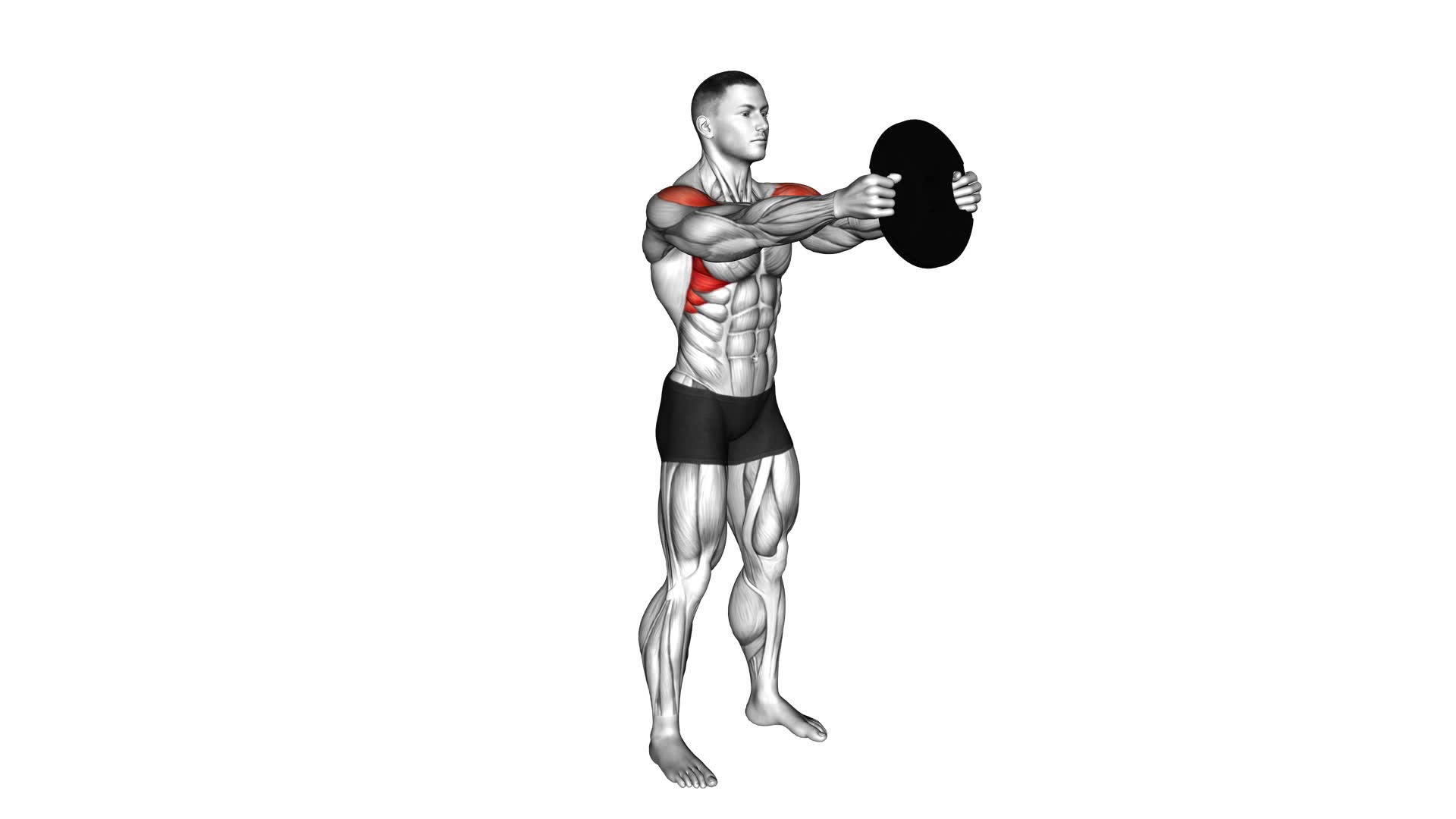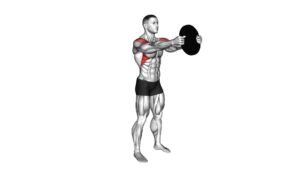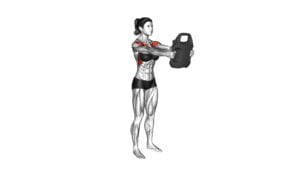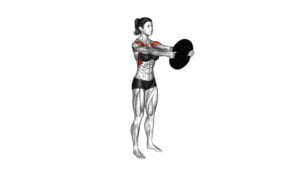Weighted Front Raise Hold – Video Exercise Guide & Tips

Are you looking to strengthen your shoulders and improve your upper body strength? Look no further than the weighted front raise hold!
Watch This Exercise Video
This exercise targets your anterior deltoids and engages your core for stability.
In this video exercise guide, you'll learn the proper form, tips for maximizing results, and common mistakes to avoid.
So grab your dumbbells and get ready to take your shoulder workout to the next level with the weighted front raise hold.
Let's get started!
Key Takeaways
- Weighted front raise hold strengthens shoulder muscles.
- It improves stability and control.
- Weighted front raise hold enhances muscle activation.
- It increases endurance and prevents fatigue.
Benefits of Weighted Front Raise Hold
One benefit of the weighted front raise hold is its ability to strengthen your shoulder muscles and improve stability. When performing this exercise, proper breathing is essential to maximize its benefits. By focusing on your breath, you can enhance muscle activation and ensure that your body is properly engaged throughout the movement.
Proper breathing during the weighted front raise hold involves inhaling deeply before lifting the weight and exhaling as you lower it back down. This controlled breathing pattern helps stabilize your core and keep your body aligned. It also allows for better oxygen flow to your muscles, enhancing their endurance and preventing fatigue.
In addition to proper breathing, the weighted front raise hold activates your shoulder muscles effectively. As you hold the weight in front of you, your deltoids, especially the anterior deltoid, are engaged to stabilize and lift the load. This not only strengthens your shoulder muscles but also improves their overall stability and control.
Transition: Now that you understand the benefits of the weighted front raise hold, let's move on to discussing the proper form for performing this exercise.
Proper Form for Weighted Front Raise Hold
To perform the weighted front raise hold correctly, follow these steps:
- Stand tall with your feet shoulder-width apart and hold a dumbbell in each hand, palms facing down.
- Engage your core and maintain a slight bend in your knees throughout the exercise.
- Slowly raise your arms straight in front of you until they're parallel to the floor, keeping your elbows slightly bent.
- Hold this position for a few seconds, focusing on maintaining proper form and engaging your shoulder muscles.
By following these steps, you can maximize shoulder gains while avoiding shoulder injuries during the weighted front raise hold.
Proper form is crucial to ensure that you're targeting the correct muscles and minimizing stress on the shoulder joint. Engaging your core and maintaining a slight bend in your knees will help stabilize your body and prevent any excessive strain on your lower back.
Additionally, keeping your elbows slightly bent throughout the exercise will alleviate stress on the elbow joint and allow for a more controlled movement. Remember to start with lighter weights and gradually increase the resistance as you become more comfortable and confident with the exercise.
Choosing the Right Weight for Weighted Front Raise Hold
To determine the appropriate weight for the weighted front raise hold, consider your current fitness level and choose a weight that challenges your muscles but still allows you to maintain proper form. It's important to warm up properly before performing this exercise to prevent injury and improve performance. A proper warm-up can include dynamic stretches, such as arm swings or shoulder circles, to loosen up the muscles and increase blood flow to the targeted areas.
The weighted front raise hold primarily targets the anterior deltoids, which are the muscles located at the front of the shoulders. Additionally, it also engages the muscles in the upper back, including the trapezius and rhomboids, as they work to stabilize the shoulder joint during the exercise. By using an appropriate weight, you can effectively target and strengthen these muscles, improving your shoulder stability and overall upper body strength.
When choosing the right weight, start with a lighter weight and gradually increase the resistance as you become stronger and more comfortable with the exercise. Remember, it's important to challenge yourself, but not to the point where you compromise your form. Aim to perform the exercise with control and without any excessive swinging or jerking motions.
Common Mistakes to Avoid in Weighted Front Raise Hold
Avoid these common mistakes when performing the weighted front raise hold to ensure proper form and maximize the effectiveness of the exercise.
Here are some common mistakes to avoid when performing the weighted front raise hold:
- Using momentum: It's important to resist the urge to swing or use momentum to lift the weight. This not only takes away from the targeted muscles but also increases the risk of injury.
- Raising the weight too high: While it's tempting to lift the weight as high as possible, it's important to maintain control and stop when your arms are parallel to the floor. Going higher can put unnecessary stress on your shoulder joints.
- Arching the back: Keep your core engaged and your back straight throughout the exercise. Arching your back can strain your lower back and take the focus away from your shoulder muscles.
- Gripping the weight too tightly: Avoid gripping the weight too tightly as it can cause tension in your forearms and wrists. Instead, hold the weight with a firm but relaxed grip.
By avoiding these common mistakes and focusing on proper form technique, you'll be able to perform the weighted front raise hold effectively and safely.
Now let's move on to the next section which covers variations and progressions of the weighted front raise hold.
Variations and Progressions of Weighted Front Raise Hold
To further challenge yourself in the weighted front raise hold exercise, there are several variations and progressions you can try.
First, experiment with different grip positions, such as a narrow or wide grip, to target different areas of the shoulder muscles.
Secondly, gradually increase the weight and reps as you build strength and endurance.
Lastly, add in shoulder external rotation by rotating your arms outward at the top of the movement to engage additional muscles and improve shoulder stability.
Different Grip Positions
Try experimenting with different grip positions to vary the challenge and target different muscles during the weighted front raise hold. Here are four grip techniques you can try:
- Overhand Grip: Hold the weight with your palms facing down. This grip primarily targets the front deltoids.
- Underhand Grip: Hold the weight with your palms facing up. This grip emphasizes the biceps and forearms while still engaging the front deltoids.
- Neutral Grip: Hold the weight with your palms facing each other. This grip recruits the muscles in your shoulders, biceps, and forearms evenly.
- Alternating Grip: Hold one weight with an overhand grip and the other with an underhand grip. This grip variation helps to engage and stabilize both sides of your body.
Increasing Weight and Reps
To increase the weight and reps for your weighted front raise hold, you can progress by gradually adding more weight or increasing the number of repetitions. Increasing the intensity of your weighted front raise hold can help enhance muscle activation and stimulate further strength gains.
When adding more weight, it's important to choose a weight that challenges you but still allows for proper form and control throughout the exercise. Start by adding small increments of weight and gradually increase as you become stronger and more comfortable.
Similarly, you can also increase the number of repetitions performed during each set to further challenge your muscles. Remember to listen to your body and progress at a pace that's suitable for your fitness level.
Adding Shoulder External Rotation
To add shoulder external rotation to your weighted front raise hold, incorporate variations and progressions that challenge your muscles in different ways. Here are four exercises that can help improve shoulder mobility and strengthen the muscles involved:
- External Rotation with Resistance Band: Attach a resistance band to a stable object and hold the other end with your arm bent at 90 degrees. Rotate your shoulder outward against the resistance of the band.
- Dumbbell External Rotation: Hold a dumbbell with your arm bent at 90 degrees. Rotate your shoulder outward, keeping your elbow tucked into your side.
- Cable External Rotation: Attach a cable to a low pulley and hold the handle with your arm bent at 90 degrees. Rotate your shoulder outward against the resistance of the cable.
- Bottoms-Up Kettlebell External Rotation: Hold a kettlebell upside down by the handle. Rotate your shoulder outward while keeping the kettlebell stable.
Tips for Maximizing Results in Weighted Front Raise Hold
To maximize results in the weighted front raise hold, it's important to focus on two key aspects: proper form technique and choosing appropriate weights.
Maintaining proper form is crucial in this exercise. It ensures that you're targeting the correct muscles and minimizes the risk of injury. By keeping your core engaged, shoulders back, and a slight bend in your elbows, you will effectively work your front deltoids.
Selecting weights that challenge you without compromising your form is equally important. It's tempting to go heavy right away, but using weights that are too heavy can lead to poor form and potential injury. Start with lighter weights and gradually increase as you build strength and endurance in your shoulders.
Proper Form Technique
To maximize your results in the weighted front raise hold, follow these tips:
- Maintain shoulder stability:
- Keep your shoulders relaxed and down
- Avoid shrugging or tensing them up
- This will help prevent any unnecessary strain on your shoulder joints
- Activate the targeted muscles:
- Focus on engaging your front deltoids (shoulder muscles) throughout the exercise
- Imagine squeezing your shoulder blades together as you lift the weights
- Control the movement:
- Avoid using momentum or swinging your arms to lift the weights
- Lift them in a slow and controlled manner
- Emphasize the contraction of your shoulder muscles
- Maintain proper posture:
- Stand tall with your chest lifted
- Keep your shoulders back
- Engage your core
- This will help you maintain stability and prevent any excessive arching or rounding of your back
Choosing Appropriate Weights
In order to maximize your results in the weighted front raise hold, it's important that you choose appropriate weights. Selecting the right weights won't only help you achieve the desired benefits of proper form, but also avoid muscle imbalances that could lead to injury.
When choosing weights for the front raise hold, start with a weight that challenges you but still allows you to maintain proper form throughout the exercise. Remember, the focus is on quality rather than quantity. Gradually increase the weight as you become stronger and more comfortable with the movement.
It's important to listen to your body and avoid using weights that are too heavy, as this can compromise your form and increase the risk of injury. By choosing appropriate weights, you can ensure that you get the most out of your weighted front raise hold while minimizing the risk of muscle imbalances.
Frequently Asked Questions
How Many Sets and Reps Should I Do for the Weighted Front Raise Hold Exercise?
For the weighted front raise hold exercise, the number of sets and reps will depend on your fitness level and goals. To build shoulder strength, start with 2-3 sets of 8-12 reps. Gradually increase the weight and intensity as you progress.
This exercise targets the deltoid muscles, improving shoulder stability and posture. It also enhances upper body strength and can help prevent injuries.
Remember to maintain proper form and consult a fitness professional for personalized guidance.
Can I Perform the Weighted Front Raise Hold Exercise With Dumbbells Instead of a Barbell?
Yes, you can definitely perform the weighted front raise hold exercise with dumbbells instead of a barbell. Using dumbbells allows for more freedom of movement and a greater range of motion. It also helps to engage different muscles in your shoulders and arms.
The weighted front raise hold exercise is a great addition to a full body workout as it targets the front deltoids, helping to improve shoulder strength and stability.
Is It Necessary to Warm up Before Doing the Weighted Front Raise Hold Exercise?
It's important to warm up before doing the weighted front raise hold exercise. Warming up helps increase blood flow to your muscles, which can prevent injuries and improve your performance. Some benefits of warming up include increased flexibility, improved range of motion, and enhanced muscle activation.
If you're looking for alternatives to the weighted front raise hold exercise, you can try other shoulder exercises like lateral raises or shoulder presses. Always consult with a fitness professional to ensure proper form and technique.
How Long Should I Hold the Weight in the Raised Position During the Exercise?
When doing the weighted front raise hold exercise, you might wonder how long to hold the weight in the raised position.
The duration of the hold can vary depending on your fitness level and goals. Holding the weight for around 10-15 seconds can help improve muscular endurance and strengthen your shoulder muscles.
However, if you're looking to build more strength, you can increase the hold time to 20-30 seconds.
Remember to listen to your body and start with a weight and duration that feels comfortable for you.
Can I Incorporate the Weighted Front Raise Hold Exercise Into My Shoulder Workout Routine?
Yes, you can definitely incorporate the weighted front raise hold exercise into your shoulder workout routine. It's a great exercise for targeting the front deltoids and improving shoulder strength.
However, if you're looking for alternatives for shoulder muscle activation, you can try exercises like shoulder presses, lateral raises, or upright rows.
It's also worth considering incorporating the weighted front raise hold into a full body workout routine to target multiple muscle groups and enhance overall strength and stability.
Conclusion
In conclusion, the weighted front raise hold is a beneficial exercise for strengthening the shoulders and arms. By following proper form and choosing the right weight, you can maximize your results and avoid common mistakes.
Additionally, there are variations and progressions of this exercise to challenge yourself as you improve. Incorporating the weighted front raise hold into your fitness routine can help you achieve stronger, more defined upper body muscles.

Author
Years ago, the spark of my life’s passion ignited in my mind the moment I stepped into the local gym for the first time. The inaugural bead of perspiration, the initial endeavor, the very first surge of endorphins, and a sense of pride that washed over me post-workout marked the beginning of my deep-seated interest in strength sports, fitness, and sports nutrition. This very curiosity blossomed rapidly into a profound fascination, propelling me to earn a Master’s degree in Physical Education from the Academy of Physical Education in Krakow, followed by a Sports Manager diploma from the Jagiellonian University. My journey of growth led me to gain more specialized qualifications, such as being a certified personal trainer with a focus on sports dietetics, a lifeguard, and an instructor for wellness and corrective gymnastics. Theoretical knowledge paired seamlessly with practical experience, reinforcing my belief that the transformation of individuals under my guidance was also a reflection of my personal growth. This belief holds true even today. Each day, I strive to push the boundaries and explore new realms. These realms gently elevate me to greater heights. The unique combination of passion for my field and the continuous quest for growth fuels my drive to break new ground.



